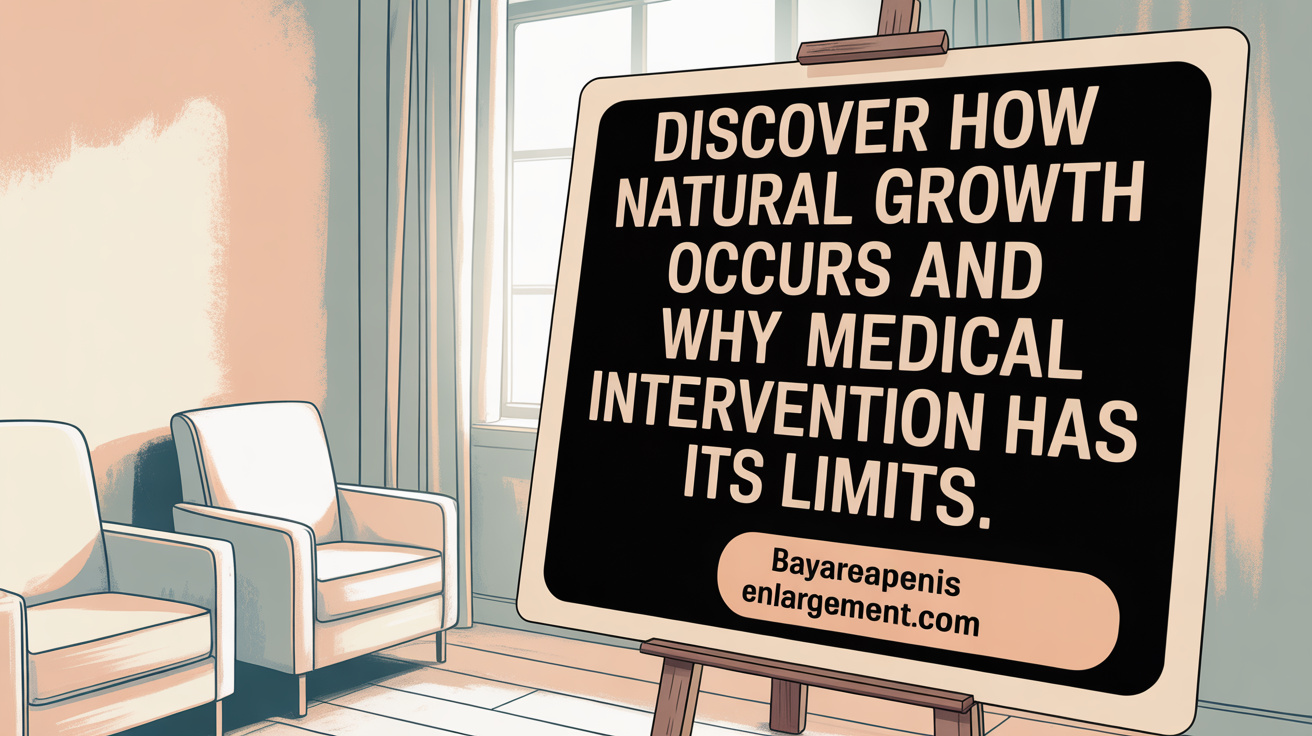Introduction to Penis Lengthening Procedures and Their Outcomes
Penis lengthening procedures attract attention for various reasons, ranging from medical necessity to cosmetic enhancement. Despite widespread interest, understanding the realistic results, risks, and limitations of these procedures is crucial before considering intervention. This article explores what can truly be expected from surgical and non-surgical penis lengthening methods, emphasizing evidence-based outcomes and safety considerations.
Understanding Natural Penis Growth and the Limits of Enlargement Procedures

How does natural penis growth progress over time?
During puberty, which typically occurs between the ages of 9 and 14, the penis undergoes significant growth. This growth phase can last from 2 to 5 years, during which both length and girth increase as part of normal development. By the end of puberty, most males reach their adult penis size, with the average erect length around 5 inches.
Is growth possible after the age of 25?
Most men will not experience natural penile growth after the age of 25. Once puberty concludes, generally by ages 18 to 20, the penis stops growing in a natural way. While some rare cases involving medical conditions or hormonal therapies can lead to growth later in life, these are exceptions rather than the rule and usually require medical intervention.
Are there medical reasons for late growth?
In uncommon situations, medical conditions such as hormonal imbalances or certain treatments may influence growth beyond typical puberty years. Conditions like hypogonadism can sometimes be treated to induce some growth, but such scenarios are rare. Generally, the prevailing medical understanding is that after puberty, the penis remains largely unchanged.
Why is understanding these natural limits important?
Many individuals considering enlargement procedures often have misconceptions about potential growth. It’s essential to have realistic expectations based on typical growth patterns. Surgical or non-surgical attempts cannot alter natural growth limits significantly, especially after puberty. Being informed helps prevent unnecessary procedures and promotes satisfaction with natural or medical options that are suitable.
| Aspect | Details | Additional Notes |
|---|---|---|
| Typical growth period | Ages 9-14 | Duration: 2-5 years |
| Average adult sizes | Length: ~5 inches | Most men are within this range |
| Growth after 25 | Usually none | Rare medical cases may vary |
| Medical interventions | Hormonal therapy | For medical conditions only |
| Realistic expectations | No natural growth post-puberty | Essential for informed decisions |
Understanding that natural penis growth predominantly occurs during adolescence helps set realistic goals and emphasizes the importance of consulting qualified medical professionals for any concerns or procedures related to penis size.
Surgical Penis Lengthening: Techniques, Expected Outcomes, and Limitations

What are the common surgical methods used for penis lengthening?
Penis lengthening surgery typically involves several procedures. The most common method is penoplasty, where the suspensory ligament of the penis is released to allow part of the erect penis to hang outside the body, improving apparent length when flaccid. This procedure can increase flaccid length by 1 to 3 centimeters (half an inch to 1.5 inches).
Another surgical approach involves the insertion of FDA-approved devices such as the Penuma® implant, which aims to increase girth and sometimes overall appearance. Additionally, some doctors perform girth enhancement using fat transfer, which can add 2 to 4 centimeters (1 to 1.5 inches) in circumference.
For longer-term girth increase, tissue engineering techniques utilizing biodegradable scaffolds have been explored. These involve autologous tissue growth to enhance girth, often with highly positive patient satisfaction reports.
How much length and girth can these surgeries typically add?
Most surgical procedures produce moderate increases. Penoplasty can add about 1 to 3 centimeters of visible length primarily when the penis is flaccid. Girth improvements through fat transfer or grafting may result in an increase of approximately 2 to 4 centimeters, depending on the technique and individual factors.
Results for lengthening are more prominent in the flaccid state, whereas changes during erection are often less noticeable. Girth enhancement techniques offer an increase in circumference with some variability in the final outcome.
What effects do these surgeries have on flaccid versus erect length?
While most procedures aim to increase the visible length in a flaccid state, their impact on erect length is limited or variable. Ligament release procedures tend to primarily affect flaccid length, with little to no significant change in erect size. Patients often notice improved appearance when flaccid, but the actual erect length may remain unchanged or only marginally improved.
How long does it take for surgical results to stabilize?
Patients typically need between 12 to 18 months for the full results of penis lengthening surgeries to become apparent. Initial post-operative swelling and healing can temporarily obscure true size, but over time, tissue settles, and final outcomes are visible. Recovery involves a rest period of about two weeks, with full healing and tissue maturation taking longer.
What are the main limitations and variable outcomes of penis lengthening operations?
The effectiveness of surgical procedures varies greatly among individuals due to differences in anatomy and healing. Many men have normal-sized penises, and surgery may not produce a significant or noticeable difference.
Risks include infection, scarring, changes in sensation, altered erectile function, and dissatisfaction. Additionally, some surgical methods may not guarantee specific results, and outcomes often do not meet exaggerated expectations.
The American Urological Association views some techniques, such as fat transfer and ligament division, with caution due to limited efficacy and possible complications. Moreover, many treatments are considered cosmetic and are not covered by insurance.
In summary, while surgical options can offer modest improvements in size, they come with potential risks and variable success rates. Realistic expectations and consultation with qualified specialists are essential to make informed decisions.
Non-Surgical Methods: Efficacy, Safety, and Realistic Benefits

What are penile extenders and traction devices, and how effective are they?
Penile extenders are traction devices designed to stretch the penis gradually over time. Scientific studies support their safety and effectiveness for lengthening when used consistently and under medical supervision. These devices can safely increase length, with some users experiencing gains of about 1 to 2 centimeters after several months of regular use.
Traction devices are generally considered a first-line non-invasive treatment. They are most effective when used as prescribed, with consistent wear enabling modest length increases. Because these devices are scientifically supported, they offer a reliable option without the risks associated with surgery.
How do hyaluronic acid fillers and other injectables work?
Hyaluronic acid fillers, commonly used for facial enhancement, are also used for penile girth augmentation. These minimally invasive injections last approximately 18 months and can increase girth by 2 to 4 centimeters. They are reversible with enzymes that dissolve the fillers.
Other injectables, such as polylactic acid or poly(methyl methacrylate) (PMMA), also enhance girth and shape with minimal downtime. These treatments have demonstrated high patient satisfaction and low complication rates.
Are vacuum pumps and penile exercises effective?
Vacuum pumps create temporary enlargements by increasing blood flow, making the penis look larger temporarily. However, current evidence does not support their use for permanent size increases.
Penile exercises like jelqing, which involve manually stretching or massaging the penis, lack scientific backing. These practices can lead to injury without producing lasting size gains.
What does scientific evidence say about these non-surgical options?
Research supports penile extenders as effective tools for lengthening, especially with long-term, regular use. Multiple studies have shown measurable gains with minimal risks. Conversely, vacuum devices and exercises like jelqing lack credible scientific evidence and have little to no long-term benefit.
Injectables such as hyaluronic acid fillers are backed by clinical studies showing significant girth improvements and high patient satisfaction.
What are the risks of non-surgical approaches?
Most non-invasive methods are relatively safe when used properly. However, potential risks include:
- For extenders: skin irritation, discomfort, and rare instances of nerve or tissue damage if improperly used.
- For fillers: swelling, bruising, lumps, or minor asymmetry.
- For vacuum pumps: skin irritation or bruising.
- For exercises like jelqing: injuries such as blood vessel damage or Peyronie’s disease.
It is essential to consult healthcare providers before initiating any non-surgical treatment to minimize risks and set realistic expectations.
Risks, Side Effects, and Complications of Penis Lengthening Procedures
What are the risks and potential side effects associated with penis enlargement procedures?
Penis enlargement surgeries are generally considered cosmetic and involve certain inherent risks. Common complications include infection, scarring, and bleeding. Infections can occur post-surgery and, while treatable, they may prolong recovery if not addressed promptly.
Erectile dysfunction and changes in sensation are notable concerns. Some surgeries might disrupt nerve pathways or tissue integrity, leading to reduced sensitivity or erectile issues. In rare cases, nerve injury could result in permanent altered sensation, affecting sexual satisfaction.
A significant factor to be aware of is fat graft resorption, especially in girth enhancement procedures using fat transfer. Typically, 5% to 25% of injected fat may be resorbed over time, sometimes leading to irregular lumps or uneven appearance. These irregularities might necessitate additional treatments.
Another risk involves permanent deformities. Unsatisfactory results or complications such as scarring may cause deformity in the penis shape or size. Such outcomes can be distressing and difficult to correct.
The importance of consulting specialized surgeons cannot be overstated. Expert professionals with experience in penile surgeries can minimize risks through meticulous technique and proper patient selection. Proper postoperative care, including infection prevention and managing swelling, also plays a crucial role in safe recovery.
Patients should thoroughly discuss potential risks with their surgeon to ensure realistic expectations and understand that no procedure guarantees specific or permanent results. Weighing these factors carefully is essential before making a decision.
Psychological and Social Considerations: Aligning Expectations and Reality
What are the common misconceptions versus the realistic expectations about penis enlargement methods?
Many men seeking larger penises often believe that non-surgical solutions like pills, creams, and pumps can dramatically increase size. However, scientific evidence shows that these methods typically offer minor or no permanent gains. Pills and topical treatments usually claim to enhance length or girth, but studies have not proven their effectiveness, and many contain potentially harmful contaminants.
Surgical options, such as fat injections or ligament release procedures, can provide some increases in length or girth, but results are variable. For example, procedures like penoplasty can add around 1 to 3 centimeters in length and 2 to 4 centimeters in girth, yet these are often modest changes. There’s also a significant risk of complications including scarring, deformities, and loss of sensitivity.
Temporary size boosts from vacuum devices or traction tools are popular but lack scientific backing for creating long-term increases. Misusing these devices can lead to tissue injury.
Understanding the actual outcomes of these procedures is essential. Most men with normal penis size—around 5 inches erect—do not need surgical intervention unless they have a medical condition like micropenis. Realistic expectations should be based on scientific data and consultations with qualified professionals, emphasizing that substantial, permanent enlargement is limited and that risks may outweigh the benefits for most individuals.
Recovery and Long-Term Outcomes After Penis Lengthening Surgery
What does the recovery process after penis lengthening surgery involve, and what results can be realistically achieved over time?
The recovery phase following penis lengthening surgery involves careful management of common post-operative symptoms. Patients typically experience swelling, bruising, pain, redness, and some discomfort, which may last from several days up to a few weeks. Adhering strictly to post-operative instructions is crucial for optimal healing.
Patients are usually advised to wear loose or compression garments to minimize swelling and support tissue healing. Heavy lifting, strenuous activities, and sexual intercourse are generally prohibited for a period ranging from 2 to 6 weeks, depending on the specific procedure and individual healing response.
Proper wound care is vital, including regular dressing changes and maintaining good hygiene to prevent infections. Antibiotics are often prescribed as a preventive measure. During recovery, initial swelling and temporary numbness are common, but these issues tend to improve gradually.
In terms of results, most patients can expect a modest increase in length and/or girth. For example, a lengthening procedure like penoplasty can add approximately 1 to 3 centimeters (half an inch to one and a half inches), primarily visible when the penis is flaccid. Girth enhancements via fat transfer can increase circumference by 2 to 4 centimeters (about 1 to 1.5 inches).
Healing and stabilization of these results occur over several months, with full outcomes often visible between 12 to 18 months post-surgery. The degree of enhancement and satisfaction vary individually, influenced by adherence to post-operative care and the specific procedure performed.
Overall, realistic expectations and proper care are essential in achieving satisfying, lasting aesthetic improvements without compromising penile function.
Key Factors Influencing Success and Safety in Penis Lengthening Procedures
What factors influence the effectiveness of penis lengthening surgeries and treatments?
The success of penis lengthening procedures depends on multiple factors, including the specific method used, the surgeon's expertise, and the patient's individual anatomy and health. Surgical techniques such as suspensory ligament release or the FDA-approved Penuma® implant can result in modest gains, especially in flaccid length, but outcomes vary widely.
Surgeon experience and skill are crucial in minimizing risks like infection, scarring, and dissatisfaction. An experienced surgeon will choose the appropriate procedure considering the patient’s goals and anatomical features, which affects both safety and results.
Patient factors such as overall health, tissue quality, and penile anatomy also influence effectiveness. For example, individuals with micropenis (a congenital condition) who otherwise meet criteria are more likely to benefit from surgery.
Psychological motivation plays a significant role; many seeking enhancement do so for appearance concerns rather than medical need. Realistic expectations are essential, since individual results can range from a slight increase in length or girth to no noticeable change, and some procedures carry considerable risks.
Additionally, scientifically validated methods like penile extenders show promising results for lengthening when used correctly and consistently. Conversely, non-evidence-based treatments—such as pills, creams, or unproven exercises—are generally ineffective and may pose health risks.
Cost and insurance coverage are other considerations. Most cosmetic procedures are out-of-pocket expenses, and patients should be aware that not all procedures guarantee desired results. Proper selection of the procedure, understanding its limitations, and consulting qualified professionals are vital steps toward achieving safe and satisfactory outcomes.
Conclusion: Informed Decisions and Realistic Goals
Penis lengthening procedures encompass a spectrum of surgical and non-surgical options, each with distinct benefits, risks, and realistic outcomes. Understanding that natural penile growth ceases after puberty, these treatments typically result in modest size increases rather than dramatic changes. Surgical methods provide more significant but still limited gains, balanced by potential complications that require careful consideration and expert medical guidance. Non-surgical options offer less invasive alternatives but generally lack robust evidence for permanent enlargement. Crucially, psychological readiness and managing expectations are fundamental to satisfaction. By prioritizing safety, validated techniques, and open communication with qualified specialists, individuals can make informed decisions that align with achievable results and overall well-being.
References
- Penis Enlargement Surgery: How It Works, Pros & Cons
- Penoplasty: penis length and girth enhancement - Top Doctors
- Want a Big Penis? Consider This First | Himplant®
- Penis enlargement surgery: Does it work, and is it worth it?
- Is Penis Enlargement Possible Without Surgery?
- Penis Enlargement: Does It Work? - WebMD
- Permanent Penis Enlargement Surgery - Sava Perovic
- Penile Augmentation: Unveiling the Facts You Need to Know
- Penis Enlargement Surgery: How It Works, Pros & Cons

